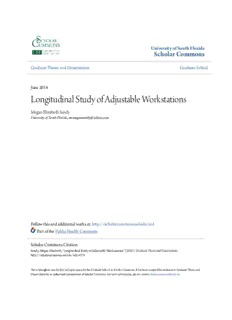
Longitudinal Study of Adjustable Workstations PDF
Preview Longitudinal Study of Adjustable Workstations
UUnniivveerrssiittyy ooff SSoouutthh FFlloorriiddaa DDiiggiittaall CCoommmmoonnss @@ UUnniivveerrssiittyy ooff SSoouutthh FFlloorriiddaa USF Tampa Graduate Theses and Dissertations USF Graduate Theses and Dissertations 6-21-2016 LLoonnggiittuuddiinnaall SSttuuddyy ooff AAddjjuussttaabbllee WWoorrkkssttaattiioonnss Megan Elizabeth Sandy University of South Florida, [email protected] Follow this and additional works at: https://digitalcommons.usf.edu/etd Part of the Public Health Commons SScchhoollaarr CCoommmmoonnss CCiittaattiioonn Sandy, Megan Elizabeth, "Longitudinal Study of Adjustable Workstations" (2016). USF Tampa Graduate Theses and Dissertations. https://digitalcommons.usf.edu/etd/6378 This Thesis is brought to you for free and open access by the USF Graduate Theses and Dissertations at Digital Commons @ University of South Florida. It has been accepted for inclusion in USF Tampa Graduate Theses and Dissertations by an authorized administrator of Digital Commons @ University of South Florida. For more information, please contact [email protected]. Longitudinal Study of Adjustable Workstations by Megan E. Sandy A dissertation submitted in partial fulfillment of the requirements for the degree of Doctor of Philosophy in Public Health Department of Environmental and Occupational Health College of Public Health University of South Florida Co-Major Professor: Thomas J. Mason, Ph.D. Co-Major Professor: Thomas E. Bernard, Ph.D. Anthony D. Banks, Ph.D. Steven P. Mylnarek, Ph.D. Date of Approval: June 26, 2016 Keywords: ergonomics, sedentary, software engineers Copyright © 2016, Megan E. Sandy Dedication To Ernest Moyer, the mentor in my life that has taught me it is not only acceptable to ask questions but imperative. Acknowledgements This research and the supporting education was made possible through the hard work of the staff and faculty of the University of South Florida (USF), College of Public Health (COPH) and Lockheed Martin. Lockheed Martin Missiles Mission Systems and Training allowed me to obtain an education and conduct research that guides improvement for the health of our employees and for others. My management team, Roy Kenton and Sorina Terrell, have fully supported this endeavor and have helped me succeed. My coworkers: Sascha Munn (and dear friend), Norm Duncan, Jason Fuentes, Victor Rodriguez, and two colleagues Nick Lane and Steve Rudnik made the research design a reality. My husband and mother have backed my education both financially and emotionally throughout the years, thank you. I would also like to specifically express my deepest appreciation to the faculty of the Department of Environmental and Occupational Health and my dissertation committee. My committee’s guidance throughout the research process provided me the opportunity to learn to think critically and as a leader. Meeting Dr. Mason ten years ago inspired me to continue work in the public health field and to pursue this degree. The NIOSH funded Sunshine Education and Research Center helped to support this research, and is a wonderful program for promotion of public health in institutions such as the University of South Florida. Lastly, I appreciate the support and direction of Anthony Banks. If it were not for him, I would not be at this juncture in my career. Table of Contents List of Tables ................................................................................................................................ iii List of Figures ............................................................................................................................... v Abstract ......................................................................................................................................... vi Chapter One: Introduction .........................................................................................................1 Public Health Significance ...............................................................................................4 Purpose of Study ...............................................................................................................6 Chapter Two: Literature Review ...............................................................................................8 Health Effects .....................................................................................................................8 Previous Studies ..............................................................................................................15 Chapter Three: Methodology ...................................................................................................22 Selection Process .............................................................................................................31 Participants ......................................................................................................................33 Interventions ....................................................................................................................34 Data Collection ................................................................................................................37 Statistical Analysis ..........................................................................................................40 Chapter Four: Results ................................................................................................................42 Chapter Five: Discussion ..........................................................................................................62 Pain and Discomfort .......................................................................................................65 Movement ........................................................................................................................68 Strengths ...........................................................................................................................74 Future Research ...............................................................................................................76 Limitations .......................................................................................................................77 Conclusion .......................................................................................................................78 References ....................................................................................................................................80 Appendices ..................................................................................................................................86 Appendix 1: Institutional Review Board Approval ...................................................87 Appendix 2: Information Sheets on Ergotron WorkFit T and S ...............................94 i Appendix 3: Hourly Activity Questionnaire ..............................................................99 Appendix 4: Baseline Questionnaire ..........................................................................100 Appendix 5 Glossary ...................................................................................................101 ii List of Tables Table 1: Outcomes Collected During the Study ....................................................................39 Table 2: Demographic of Study Participants .........................................................................43 Table 3: Mean Head Discomfort Rating ..................................................................................44 Table 4: Mean Trunk Discomfort Rating ................................................................................45 Table 5: Mean Arms Discomfort Rating .................................................................................46 Table 6: Mean Lower Body Discomfort Rating .....................................................................48 Table 7: Odds Ratios of Arm Discomfort ...............................................................................49 Table 8: Odds Ratios of Head Discomfort ..............................................................................50 Table 9: Odds Ratios of Trunk Discomfort .............................................................................50 Table 10: Odds Ratios of Lower Body Discomfort ................................................................50 Table 11: Mean Time Spent Standing per Day Each Week ..................................................51 Table 12: Repeated Measures Analysis of Standing Time ...................................................51 Table 13: Mean Time Spent Sitting by Day Each Week ........................................................54 Table 14: Repeated Measures Analysis of Seated Time ........................................................54 Table 15: Mean Time Spent Walking per Day by Group .....................................................56 Table 16: Repeated Measures Analysis of Walking Time ....................................................56 Table 17: Mean Keystrokes by Group over Time ..................................................................58 Table 18: Repeated Measures Analysis of Keystrokes ..........................................................59 iii Table 19: Mean Fatigue Indicators by Group over Time ......................................................60 Table 20: Repeated Measures Analysis of Fatigue Indicators .............................................61 Table 21: Mean Difference in Overtime and Lost Time for Intervention Groups ............61 iv List of Figures Figure 1: ErgoSuite Icon Available for Users 24/7 ...............................................................24 Figure 2: ErgoSuite Discomfort Notes ....................................................................................25 Figure 3: ErgoSuite Discomfort Note Region of the Body ...................................................26 Figure 4: ErgoSuite Discomfort Note Likert Scale ................................................................26 Figure 5: Fatigue Indicators Calculation ................................................................................27 Figure 6: Flow Diagram of Study Setup and Data Collection over Time ..........................30 Figure 7: Ergotron WorkFit- T .................................................................................................36 Figure 8: Ergotron WorkFit- S (Single and Dual) ..................................................................36 Figure 9: Linear Trend of Mean Head Discomfort Rating for Each Group .......................44 Figure 10: Linear Trend of Mean Trunk Discomfort Rating for Each Group ...................46 Figure 11: Linear Trend of Mean Arms Discomfort Rating for Each Group .....................47 Figure 12: Linear Trend of Mean Lower Body Discomfort Rating for Each Group .........48 Figure 13: Hours Spent Standing by Group over Time ........................................................52 Figure 14: Hours Spent Seated by Group over Time ............................................................55 Figure 15: Hours Spent Walking by Group over Time ........................................................57 Figure 16: Weekly Average Keystrokes by Group over Time .............................................58 Figure 17: Weekly Average Fatigue Indicators by Group over Time ................................60 v
Description: